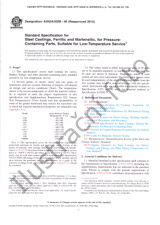Potřebujeme váš souhlas k využití jednotlivých dat, aby se vám mimo jiné mohly ukazovat informace týkající se vašich zájmů. Souhlas udělíte kliknutím na tlačítko „OK“.
ASTM D3339-21
Standard Test Method for Acid Number of Petroleum Products by Semi-Micro Color Indicator Titration
Přeložit název
NORMA vydána dne 1.11.2021
Informace o normě:
Označení normy: ASTM D3339-21
Datum vydání normy: 1.11.2021
Kód zboží: NS-1043766
Počet stran: 8
Přibližná hmotnost: 24 g (0.05 liber)
Země: Americká technická norma
Kategorie: Technické normy ASTM
Kategorie - podobné normy:
Anotace textu normy ASTM D3339-21 :
Keywords:
acid number, petroleum products, semi-micro color indicator titration,, ICS Number Code 75.080 (Petroleum products in general)
Doplňující informace
| Significance and Use | ||||||||
|
5.1?This test method measures the acid number of oils obtained from laboratory oxidation tests using smaller amounts of sample than Test Methods D974 or D664. It has specific application in Test Method D943 in which small aliquots of oil are periodically removed for testing by Test Method D3339. This test method, therefore, provides a means of monitoring the relative oxidation of oils, by measuring changes in acid number, at different time intervals and under the various oxidizing test conditions. |
||||||||
| 1. Scope | ||||||||
|
1.1?This test method covers the determination of acidic constituents in new or used petroleum products and lubricants soluble or nearly soluble in mixtures of toluene, and isopropyl alcohol. The test method is especially intended for cases in which the amount of sample available to be analyzed is too small to allow accurate analysis by Test Methods D974 or D664. It is applicable for the determination of acids having dissociation constants in water larger than 10?9. Extremely weak acids having dissociation constants smaller than 10?9 do not interfere. Salts titrate if their hydrolysis constants are larger than 10?9. 1.2?This test method can be used to indicate relative changes in acid number that occur in an oil during use under oxidizing conditions. Although the titration is made under definite equilibrium conditions, the method does not measure an absolute acidic property that can be used to predict performance of an oil under service conditions. No general relationship between bearing corrosion and acid number is known. 1.3?Since this test method requires substantially less sample than Test Methods D974 or D664, it provides an advantageous means of monitoring an oxidation test by changes in acid number by (Note 1:?Some oils, such as many cutting oils, rust-proofing oils, and similar compounded oils, or excessively dark-colored oils, may be more difficult to analyze by this test method due to obscurity of the color-indicator end point. These oils can be analyzed by Test Method D664 provided sufficient sample is available. However, this situation is much less likely using Test Method D3339 than using Test Method D974 due to the use of a more highly dilute sample during the titration and due to the greater stability of the end point color change. The acid numbers obtained by Test Method D3339 may or may not be numerically the same as those obtained by Test Method D664 but they should be of the same order of magnitude. Note 2:?The results obtained using this method have been found
to be numerically the same as those obtained using Test Method
D974, within the precision of
the two methods, for new or oxidized lubricants of the type
primarily intended for hydraulic or steam turbine type service. The
oxidized lubricants were obtained using the Test Method
D943 oxidation test. This
correlation is shown by the correlation coefficient r = 0.989 with slope s = + 1.017 and intercept y = + 0.029, calculated using the acid
numbers obtained using both titration methods for the samples used
for the precision statement (12.2).2
1.4?The values stated in SI units are to be regarded as standard. No other units of measurement are included in this standard. 1.5?This standard does not purport to address all of the safety concerns, if any, associated with its use. It is the responsibility of the user of this standard to establish appropriate safety, health, and environmental practices and determine the applicability of regulatory limitations prior to use. 1.6?This international standard was developed in accordance with internationally recognized principles on standardization established in the Decision on Principles for the Development of International Standards, Guides and Recommendations issued by the World Trade Organization Technical Barriers to Trade (TBT) Committee. |
||||||||
| 2. Referenced Documents | ||||||||
|
Doporučujeme:
Aktualizace technických norem
Chcete mít jistotu, že používáte pouze platné technické normy?
Nabízíme Vám řešení, které Vám zajistí měsíční přehled o aktuálnosti norem, které používáte.
Chcete vědět více informací? Podívejte se na tuto stránku.




 Cookies
Cookies
